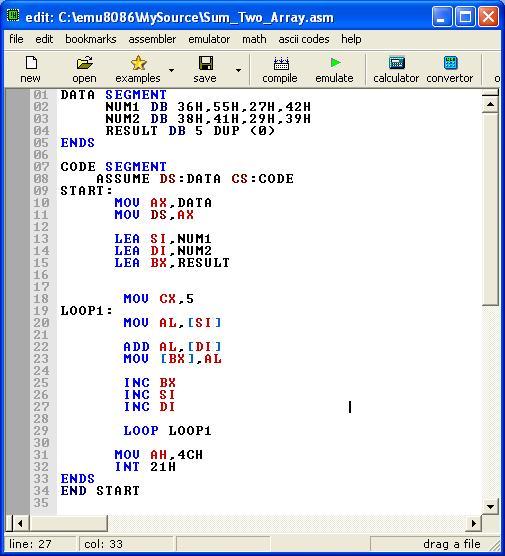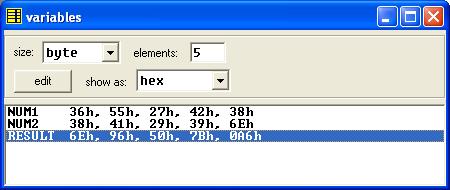Now we will write another Assembly Program, which should add two 5-byte numbers (numbers are stored in array- NUM1 & NUM2), and stores the sum in another array named RESULT.
Let’s identify variables needed for this program.
First variables will be the one which will hold the values present in the Given Arrays and it will be NUM1 and NUM2 . Other variable will be holding the Result of Array Addition and it will be RESULT, So in all Three variables.
The identified variables are NUM1, NUM2 and RESULT.
First Line – DATA SEGMENT
DATA SEGMENT is the starting point of the Data Segment in a Program and DATA is the name given to this segment and SEGMENT is the keyword for defining Segments, Where we can declare our variables.
Next Line – NUM1 DB 36H,55H,27H,42H
NUM2 DB 38H,41H,29H,39H
RESULT DB 5 DUP (0)
NUM1 DB 36H,55H,27H,42H and NUM2 DB 38H,41H,29H,39H this line is a declaration of 8-bit Numbers Array initialized with 36H,55H,27H,42H and 38H,41H,29H,39H the numbers are seperated by Comma (,). RESULT DB 5 DUP (0) is used to Save the Result of Array Addition which will save sum of each elements of a Array NUM1 and NUM2. DUP is used to Duplicate the value in the Bracket ahead.
Next Line – DATA ENDS
DATA ENDS is the End point of the Data Segment in a Program. We can write just ENDS But to differentiate the end of which segment it is of which we have to write the same name given to the Data Segment.
Now, Selection of data type is DB data type the numbers which we are adding will be integers so DB is sufficient.
[codesyntax lang=”asm”]
DATA SEGMENT
NUM1 DB 36H,55H,27H,42H
NUM2 DB 38H,41H,29H,39H
RESULT DB 5 DUP (0)
ENDS
[/codesyntax]
In Assembly programming, the variable are all defined by bytes only.
DB – Define Byte (Size – 1 Byte)
DW – Define Word (Size – 2 Byte)
DD – Define Double word (Size – 4 Bytes)
DQ – Define Quad word (Size – 8 Bytes)
DT – Define Ten Bytes (Size – 10 Bytes)
NUMBER SYSTEM in Assembly Programming is Decimal, Octal, Hexadecimal, Binary.
In the Program, We are entering the values for the variables and Do arithmetical Operations like Addition, Subtraction, Multiplication and Division So the Computer should understand which kind of Number is entered. Hence there is a different letters for different Number Systems. O or o stands for Octal, H or h stands for Hexadecimal, B or b stands for Binary, D or d stands for Decimal. By default type of numbering system is Decimal. If you do not specify any letter then the number is understood to be Decimal (By default).
[codesyntax lang=”asm”]
DATA SEGMENT
NUM1 DB 36H,55H,27H,42H
NUM2 DB 38H,41H,29H,39H
RESULT DB 5 DUP (0)
ENDS
CODE SEGMENT
ASSUME DS:DATA CS:CODE
START:
MOV AX,DATA
MOV DS,AX
LEA SI,NUM1
LEA DI,NUM2
LEA BX,RESULT
MOV CX,5
LOOP1:
MOV AL,[SI]
ADD AL,[DI]
MOV [BX],AL
INC BX
INC SI
INC DI
LOOP LOOP1
MOV AH,4CH
INT 21H
ENDS
END START
[/codesyntax]
Explanation :
In this Assembly Language Programming, A single program is divided into four Segments which are 1. Data Segment, 2. Code Segment, 3. Stack Segment, and 4. Extra Segment. Now, from these one is compulsory i.e. Code Segment if at all you don’t need variable(s) for your program.if you need variable(s) for your program you will need two Segments i.e. Code Segment and Data Segment.
Next Line – CODE SEGMENT
CODE SEGMENT is the starting point of the Code Segment in a Program and CODE is the name given to this segment and SEGMENT is the keyword for defining Segments, Where we can write the coding of the program.
Next Line – ASSUME DS:DATA CS:CODE
In this Assembly Language Programming, their are Different Registers present for Different Purpose So we have to assume DATA is the name given to Data Segment register and CODE is the name given to Code Segment register (SS,ES are used in the same way as CS,DS )
Next Line – START:
START is the label used to show the starting point of the code which is written in the Code Segment. : is used to define a label as in C programming.
Next Line – MOV AX,DATA
MOV DS,AX
After Assuming DATA and CODE Segment, Still it is compulsory to initialize Data Segment to DS register. MOV is a keyword to move the second element into the first element. But we cannot move DATA Directly to DS due to MOV commands restriction, Hence we move DATA to AX and then from AX to DS. AX is the first and most important register in the ALU unit. This part is also called INITIALIZATION OF DATA SEGMENT and It is important so that the Data elements or variables in the DATA Segment are made accessable. Other Segments are not needed to be initialized, Only assuming is enhalf.
Next Line – LEA SI,NUM1
LEA DI,NUM2
LEA BX,RESULT
LEA SI,NUM1 in this LEA stands for LOAD EFFECTIVE ADDRESS and it loads the effective address of second element into the first element. This same code can be interchangably written as MOV DX, OFFSET PRICE where OFFSET means effective address and MOV means move second element into the first element. Here Base Address of variable PRICE is loaded in DX register. Similarly For LEA DI,NUM2 and LEA BX,RESULT.
Next Line – MOV CX,5
MOV CX,5 is used to move or assign value 5 ( Since the array is of length 5 ) to CX. The program which we are wishing to write is to input eight characters from console which will be entered by the user, Hence to do so we need a loop construct. In assembly programming language we have a LOOP instruction. This works with two other helpers which are Label and Counter. The Loop start with LABEL and ends with LOOP instruction with the same LABEL name with it. the execution of the Loop depends on the value in CX register ( CX is also Called COUNTER).
Next Line – LOOP1:
LOOP1: is a LABEL and all the words ending in colon (:).
Next Line – MOV AL,[SI]
MOV AL,[SI] means move value in Address of SI register to AL register. [] is Refered as Value present in the Address of the Register in it.
Next Line – ADD AL,[DI]
ADD AL,[DI] means Add value in AL register with value in Address of SI register. DAA means Decimal Adjust after Addition. e.g. 36H is present in AL register, If added with 0AH will give 40H. After DAA it will Convert to Decimal equivalent to 46H.
Next Line – MOV [BX],AL
MOV [BX],AL means move value in AL register to Address of BX register. [] is Refered as Value present in the Address of the Register in it.
Next Line – INC BX
INC SI
INC DI
INC BX will increment the Address value present in BX register. Here we are using BX register as a counter and counting the numbers of Array elements to Cover all the Five elements. Similarly For INC SI and INC DI.
Next Line – LOOP LOOP1
This end of loop. In assembly programming language we have a LOOP instruction. This works with two other helpers which are Label and Counter. The Loop start with LABEL and ends with LOOP instruction with the same LABEL name with it. the execution of the Loop depends on the value in CX register ( CX is also Called COUNTER).
Next Line – MOV AH,4CH
INT 21H
The above two line code is used to exit to dos or exit to operating system. Standard Input and Standard Output related Interupts are found in INT 21H which is also called as DOS interrupt. It works with the value of AH register, If the Value is 4ch, That means Return to Operating System or DOS which is the End of the program.
Next Line – CODE ENDS
CODE ENDS is the End point of the Code Segment in a Program. We can write just ENDS But to differentiate the end of which segment it is of which we have to write the same name given to the Code Segment.
Last Line – END START
END START is the end of the label used to show the ending point of the code which is written in the Code Segment.
Note :- In this Assembly Language Programming, We have Com format and EXE format. We are Learning in EXE format only which simple then COM format to understand and Write. We can write the program in lower or upper case, But i prepare Upper Case.
Screen Shots :-
Before Execution :-
After Execution :-
Note :- To see the variable and its value you have to click vars button in the emulator.



